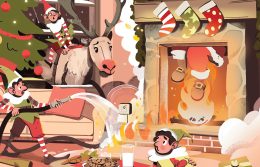A Guide to Fire Hazards in the Home
Our homes are meant to be our safe havens. That’s why it’s important to protect them from potential dangers — including fire hazards, some of which become particularly prevalent during winter.
Unfortunately, house fires are more common than you might think. In fact, there were more than 356,000 home fires in 2020, resulting in 2,580 deaths and more than $8.4 million in property damage, according to the National Fire Protection Association.
With the right knowledge and precautions, you can help keep your home and family safe. Follow this room-by-room guide to fire hazards in the home to see where your home might be vulnerable.
Bathroom
- Exhaust fan: Often overlooked, this fan can get clogged with dust and lint, causing it to overheat. Many older models don’t have thermal protection, so if you notice an odd smell or a loud noise, it might be time to replace it.
- Hair-styling tools: It takes a lot to get Texas-worthy hair. But remember to turn off that flat iron or curling iron before leaving the house. (Both can reach approximately 425 F!) Consider investing in tools that automatically shut off to give yourself peace of mind.
Bedroom
- Charging devices: Don’t place your charging smartphone or laptop underneath a blanket or pillow. Give the device room to “breathe.”
- Electric cords: Keep electric cords above carpets and away from walls, where heat can quickly build.
- Electric blankets: Lay blankets flat so the wiring doesn’t get damaged, and don’t use them with a heated mattress pad, which could cause overheating.
Garage
- Faulty wiring: This can happen elsewhere throughout your home, but electrical malfunctions are a main cause of garage fires as these areas sometimes play second fiddle to the rest of the property.
- Flammable liquids: Keep more obvious home fire hazards like gasoline, chemicals, and other flammable liquids in tightly sealed metal containers away from potential heat sources.
Kitchen
- Stovetop: Keep your stovetop clean. A small flame can quickly get out of hand once it makes contact with flammable grease and caked-on food from past dishes.
- Oven: It may sound like common sense, but it bears mentioning: Never leave the house unattended while the oven is on. Be sure to turn it off immediately after you’ve finished using it.
- Curtains and dish towels: An awry flame can jump to a flowing curtain or nearby kitchen towel. Fabrics should be stored or displayed away from sources of heat.
Laundry Room
Dryer: Regularly clean the lint trap in your dryer. Residue from dryer sheets can build up over time, creating a possible fire hazard in the home. While you’re there, don’t forget to clean out the dryer vent hose.
Living Room
- Fireplace: There’s nothing quite like the crackle of a fireplace on a cold night. But before you light up, make sure the chimney is inspected and cleaned by a professional at least once a year. Keep a metal or glass screen in front of the fireplace to contain embers. Learn more about wood-burning fireplace and stove safety.
- Candles: While they enhance a room’s ambience, candles are common home fire hazards that accounted for over 7,000 house fires in 2018. Never leave a flame unattended, and keep candles in a sturdy holder at least 12 feet away from anything that could easily catch fire, such as a curtain.
Your Family’s Fire Plan
Preparing your home and practicing safety is important, but so is being prepared in case an accident should ever happen. Make sure your family has a fire emergency plan in place, and practice it at least twice a year to ensure that everyone knows what to do. Also make sure all family members know where your fire extinguishers are and how to use them.
If you’d like to learn more about what your insurance policy covers in the event of a fire, call your Texas Farm Bureau Insurance Agent.
Coverage and discounts are subject to qualifications and policy terms and may vary by situation. © 2021 Texas Farm Bureau Insurance



